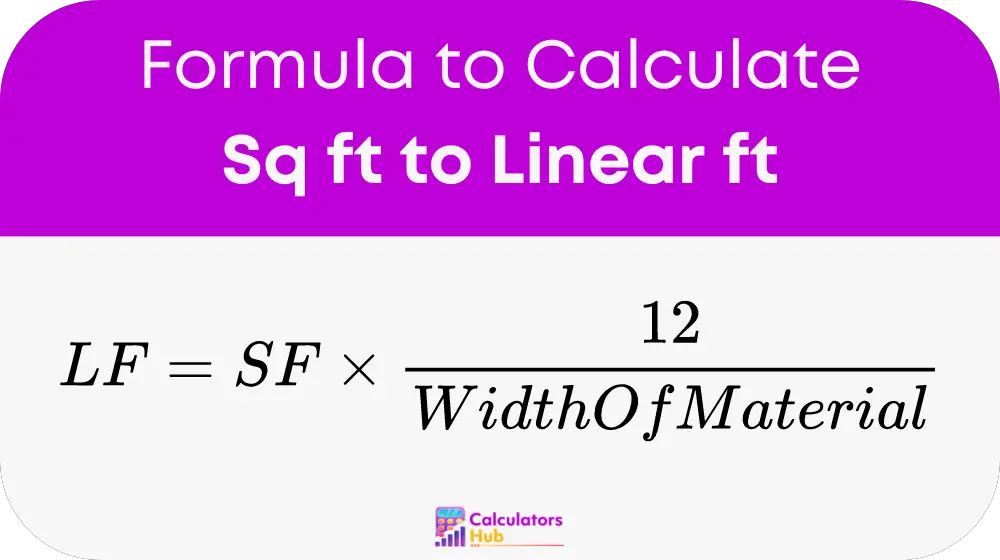Linear Ft To Sq Ft

Converting linear feet to square feet is a fundamental concept in various fields such as construction, interior design, and landscaping. Understanding the difference between linear and square measurements is crucial for accurately calculating the amount of materials needed for a project or assessing the size of a space.
Linear feet refer to a measurement of length, typically used for objects that are long and narrow, such as flooring, fencing, or molding. It represents the total length of an item or a collection of items laid end to end. For example, if you have three pieces of lumber, each 4 feet long, the total linear footage would be 12 feet.
On the other hand, square feet are a unit of area, used to measure the size of a two-dimensional space, like a room, a yard, or a piece of fabric. It represents the total area enclosed by a shape, calculated by multiplying the length and width of the space. For instance, a room that measures 10 feet by 10 feet has an area of 100 square feet.
To convert linear feet to square feet, you need to know the width of the material or space in question. The formula for converting linear feet to square feet is:
Square Feet = Linear Feet x Width
For example, if you have 100 linear feet of 5-foot wide carpeting, the calculation would be:
Square Feet = 100 linear feet x 5 feet Square Feet = 500 square feet
This means you have 500 square feet of carpeting.
In contrast, if you’re working with a fixed width and need to calculate the linear feet required to cover a certain area, you can rearrange the formula:
Linear Feet = Square Feet / Width
For example, if you want to cover a 500 square foot area with 4-foot wide flooring, the calculation would be:
Linear Feet = 500 square feet / 4 feet Linear Feet = 125 linear feet
This means you would need 125 linear feet of 4-foot wide flooring to cover the area.
Why Accurate Conversion Matters
Accurate conversion between linear and square feet is essential for several reasons:
- Material Calculation: Incorrect calculations can lead to overestimation or underestimation of materials needed, resulting in wasted resources or project delays.
- Cost Estimation: Accurate material calculation directly affects cost estimation. Incorrect conversions can inflate or deflate project costs, impacting budget planning.
- Space Planning: Understanding the area of a space in square feet helps in planning and designing the space more efficiently, from furniture arrangement to utility placement.
- Regulatory Compliance: In construction and real estate, accurate measurements are crucial for compliance with zoning laws, tax assessments, and property valuations.
Best Practices for Conversion
- Understand the Context: Always consider the context of your measurement. Know whether you’re dealing with linear or square feet and ensure your calculations reflect this.
- Double-Check Calculations: Given the importance of accuracy, it’s wise to double-check your calculations, especially in professional or large-scale projects.
- Use Conversion Tools: Utilize online conversion tools or calculators to streamline your calculations, especially for complex projects or when dealing with multiple measurements.
- Keep Records: Maintain detailed records of your measurements and calculations. This practice helps in tracking changes, revisions, and ensuring that all stakeholders are on the same page.
In conclusion, the conversion between linear feet and square feet is a straightforward process once you understand the basic principles. By applying the formula and considering the width of the material or space, you can accurately calculate either the linear feet from square feet or vice versa. Remember, precision in these calculations is key to successful project execution in various industries.
What is the difference between linear feet and square feet?
+Linear feet measure length, typically used for long, narrow objects, while square feet measure area, representing the total space enclosed by a shape.
How do I convert linear feet to square feet?
+To convert linear feet to square feet, you multiply the linear feet by the width of the material or space.
Why is accurate conversion between linear and square feet important?
+Accurate conversion is crucial for material calculation, cost estimation, space planning, and regulatory compliance, ensuring projects are executed efficiently and correctly.
By focusing on accurate conversions and maintaining awareness of the differences between linear and square measurements, professionals and DIY enthusiasts alike can ensure their projects are well-planned, efficiently executed, and meet all necessary standards and regulations.


